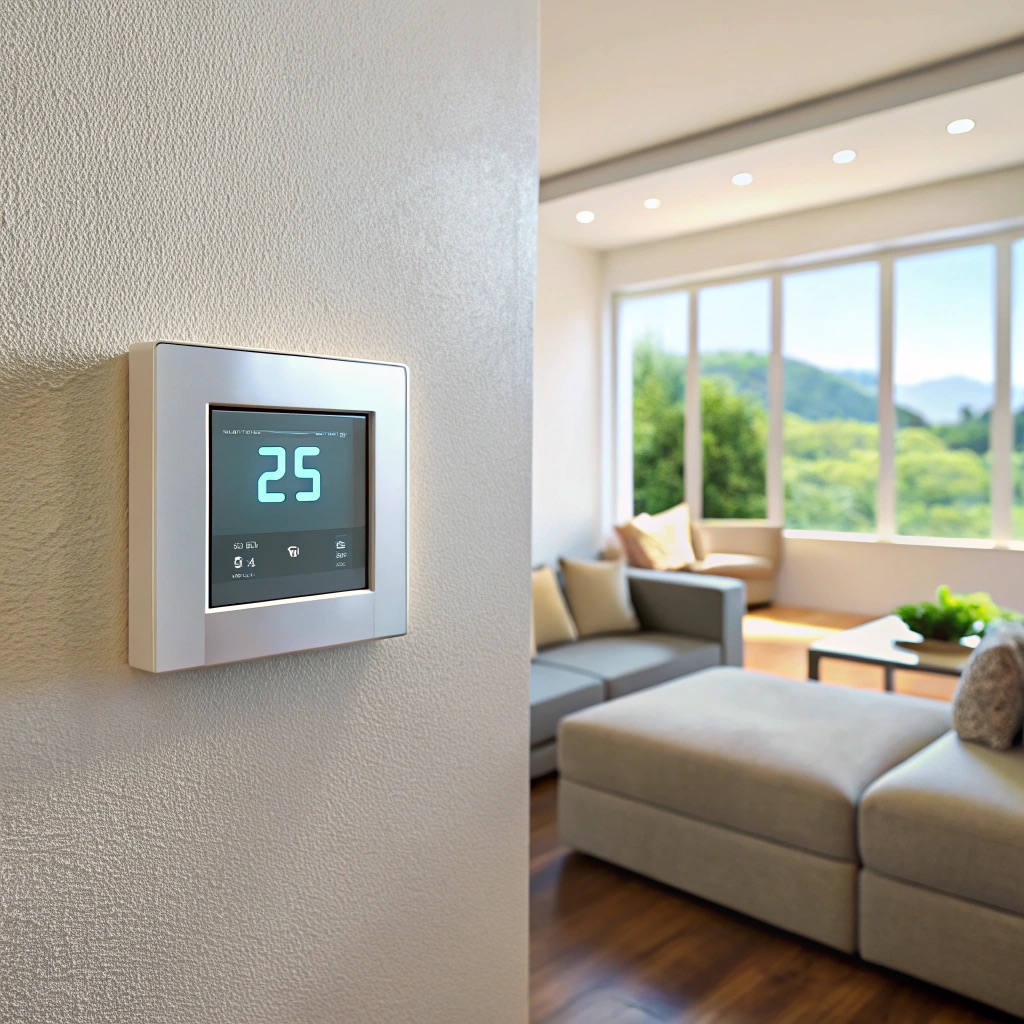Last updated on
Discover simple yet effective ways to transform your gloomy kitchen into a bright and inviting space with these practical tips and tricks.
Are you tired of cooking in a gloomy kitchen that feels like a cave? A dark kitchen can make even the most delicious meal lose its appeal. But don’t worry, there are simple ways to brighten up your space and make it feel more inviting.
In this article, we’ll share some tips and tricks on how to bring light into your dark kitchen and create a warm and welcoming atmosphere that you’ll love spending time in. So let’s get started!
Key takeaways:
- Assess your lighting fixtures for proper illumination.
- Maximize natural light sources through cleaning and window treatments.
- Consider adding additional light sources such as overhead or under-cabinet lights.
- Replace solid doors with glass or French-style doors.
- Upgrade to LED light bulbs for brighter and energy-efficient lighting.
What's Inside
Assess Your Lighting

The first step in brightening up your dark kitchen is to assess your lighting. Take a look at the current lighting fixtures and determine if they are providing enough light for the space.
If not, it’s time to make some changes.
Start by identifying any areas of the kitchen that are particularly dim or shadowy. These could be corners, cabinets, or countertops that don’t receive much natural light during the day.
Once you’ve identified these problem areas, consider adding additional sources of light such as overhead lights or under-cabinet lights. You may also want to replace outdated fixtures with newer ones that provide brighter illumination.
Natural Light Solutions
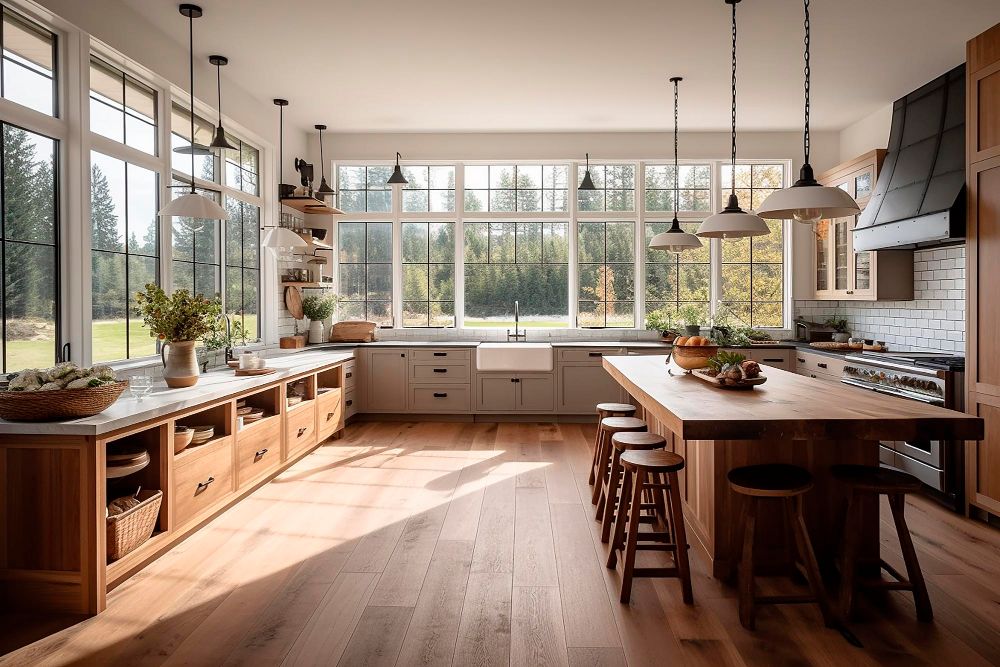
Take a look at where the light sources are coming from and how much natural light enters your space. If you have windows, consider their size and placement.
One of the best ways to bring more light into your kitchen is by maximizing natural light sources. Start by cleaning any dirty windows or removing heavy curtains that block out sunlight.
Consider adding sheer window treatments that allow for privacy while still letting in plenty of daylight.
Add a Window.
If possible, add another window to increase natural lighting in your kitchen area. This can be an expensive option but it will make a significant difference if done correctly.
Opt for Skylights.
Another way to bring more sunshine into your home is through skylights installation on top of roofs or ceilings which allows direct sunlight inside without taking up wall space like traditional windows do.
Lighter Window Treatments.
Choose lighter-colored blinds or shades instead of heavy drapes as they tend not only let more sun rays pass through but also reflect them around the room making it brighter overall.
Add a Window
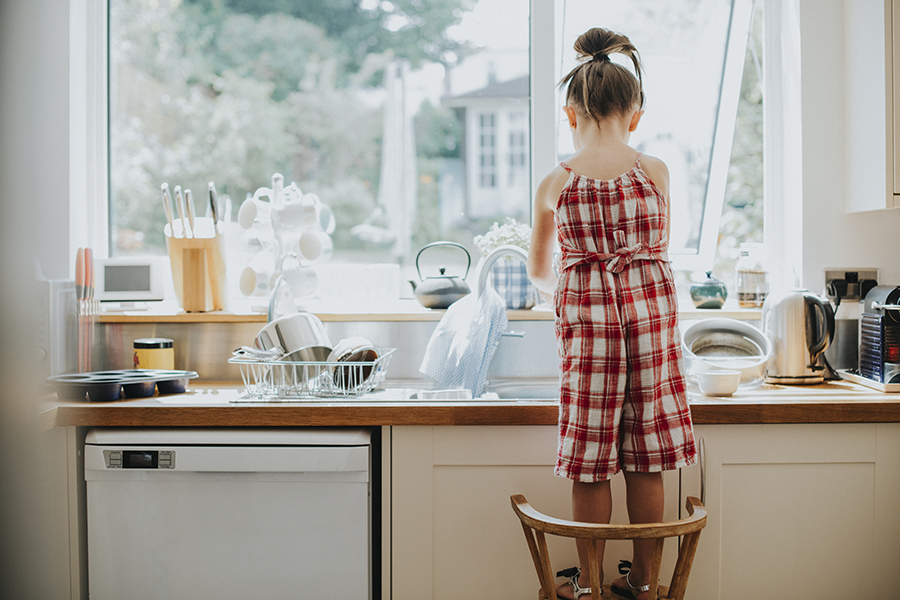
A window not only brings in more light but also adds visual interest to the space. Consider the position of your kitchen and where you could add a window for maximum impact.
If possible, choose a spot that faces south or west to capture as much sunlight as possible throughout the day.
Adding a new window may require some construction work and professional help, so make sure you have budgeted accordingly before starting any project. However, if installing an entirely new one isn’t feasible due to structural limitations or cost constraints, consider enlarging an existing one instead.
A larger opening will allow more natural light into your kitchen while creating better ventilation too! You can also opt for frosted glass windows if privacy is a concern without sacrificing on brightness levels.
Opt for Skylights
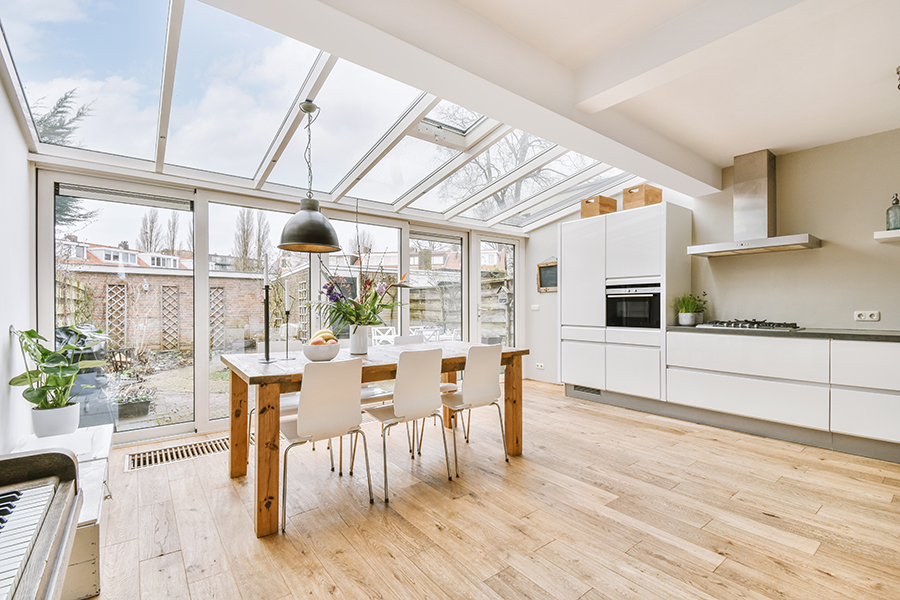
They can be installed in the ceiling and provide an excellent source of sunlight during the day. Skylights come in different shapes and sizes, so you can choose one that fits your kitchen’s design.
If you have a flat roof, consider installing a skylight that is flush with the surface for maximum light exposure. If you have a sloped roof, opt for angled skylights to allow more sunlight into your space.
One thing to keep in mind when installing skylights is their placement. You want them positioned where they will receive direct sunlight throughout most of the day but also avoid overheating or glare issues.
Lighter Window Treatments
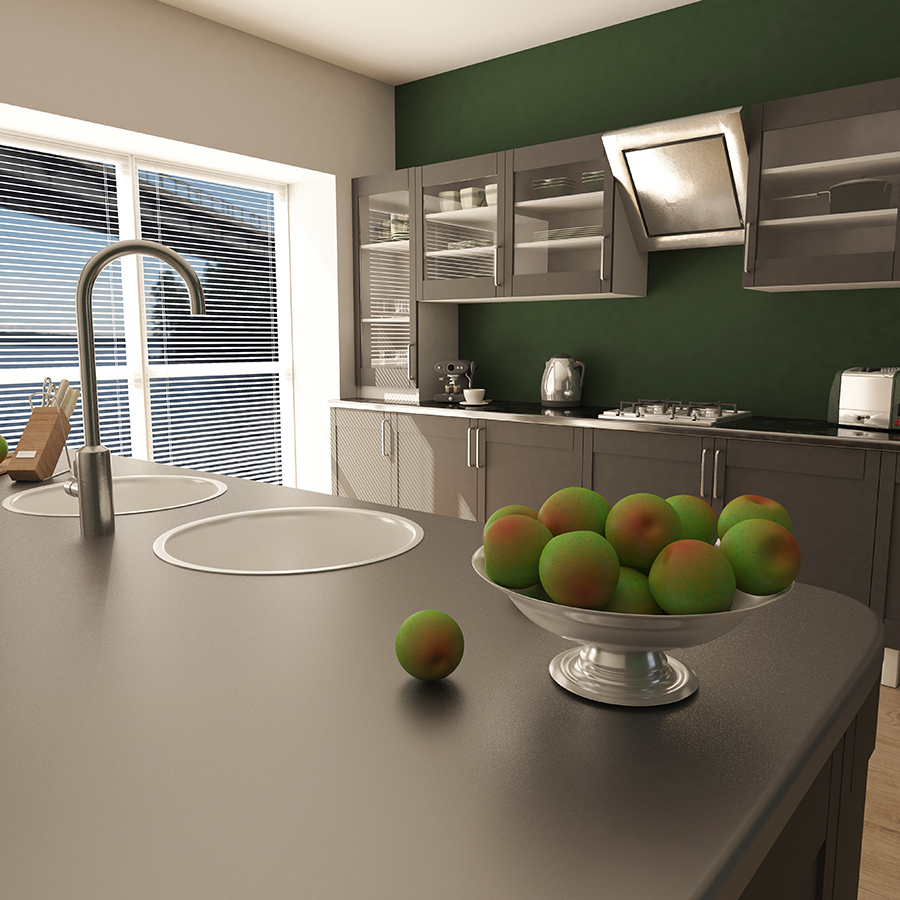
Heavy curtains or drapes can block natural light and make the room feel smaller and darker. Instead, opt for lighter window treatments such as sheer curtains or blinds that allow more sunlight to enter the space.
If you prefer privacy, consider using frosted glass film on your windows instead of heavy curtains. This will still let in plenty of natural light while providing some level of privacy.
Another option is to use Roman shades made from lightweight fabrics like linen or cotton. These shades are easy to install and provide a clean look that complements any decor style.
Replace Solid Doors

Replacing solid doors with glass or French-style doors is an excellent way to brighten up your kitchen and create a more open and airy atmosphere. Glass or French-style doors allow natural light to flow into the room, making it feel brighter and more inviting.
If you have a pantry or storage closet in your kitchen that has a solid door, consider replacing it with glass panels. This will not only add visual interest but also allow you to see what’s inside without having to open the door.
Replacing solid cabinet doors with glass ones is another option for bringing more light into your dark kitchen. Glass cabinet fronts are perfect for displaying decorative items such as dishes, glasses, and vases while adding brightness at the same time.
Overhead Lighting Solutions
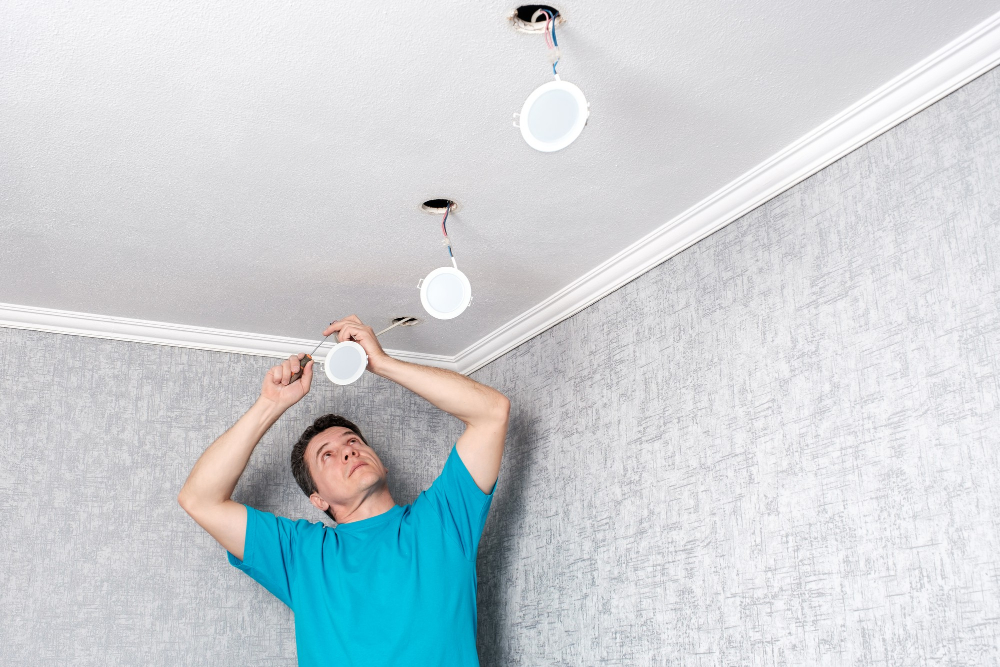
It can make all the difference in creating a bright and welcoming atmosphere. There are several overhead lighting solutions that you can consider to brighten up your space.
One option is to install recessed lights, which provide even illumination throughout the room without taking up too much visual space. Another option is pendant lights, which add style and personality while also providing ample light for cooking and dining areas.
If your kitchen has high ceilings or an open floor plan, chandeliers or large statement fixtures may be suitable options as well. These types of fixtures not only provide plenty of light but also serve as eye-catching focal points that draw attention upward.
When choosing overhead lighting solutions for your dark kitchen, it’s important to consider both functionality and aesthetics.
Invest in Light Fixtures
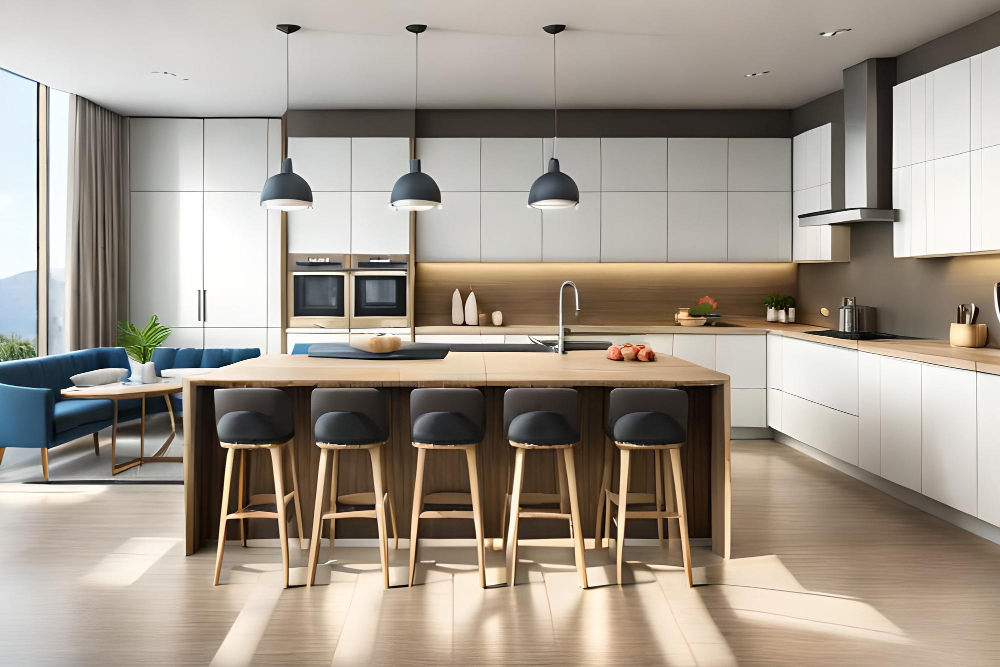
If you have a dark kitchen, investing in light fixtures is one of the easiest ways to brighten it up. There are many options available that can suit different styles and budgets.
Consider installing pendant lights over your island or dining table for focused lighting that adds warmth to your space. Recessed lighting is another option that provides even illumination throughout the room without taking up too much visual space.
If you prefer something more decorative, chandeliers or flush mount ceiling lights with crystal accents add elegance and sparkle while providing ample light. You could also opt for track lighting if you want flexibility in directing light where it’s needed most.
When choosing light fixtures, keep in mind their size and placement relative to other elements such as cabinets or countertops so they don’t overpower them visually but instead complement them nicely.
Recessed Lighting
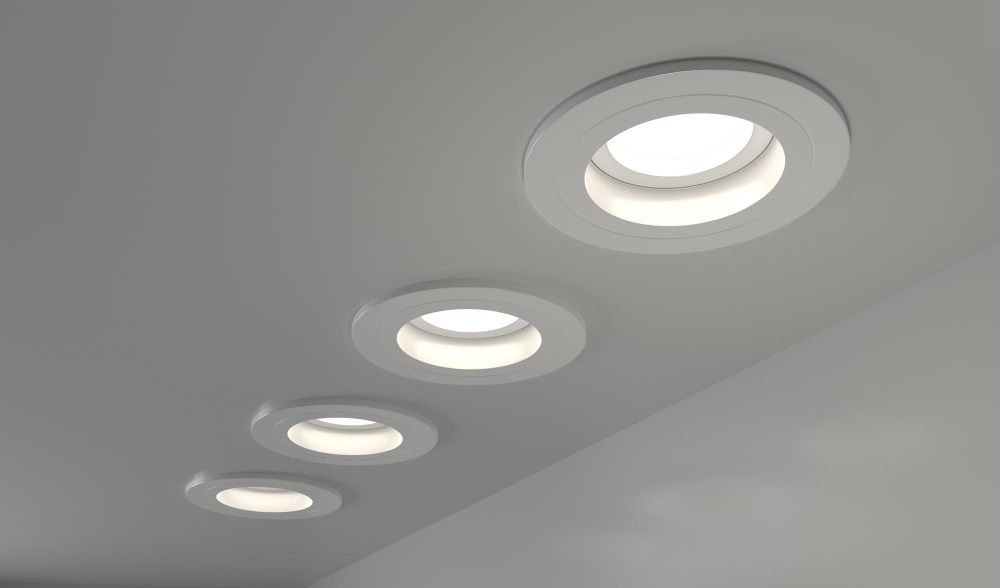
These lights are installed into the ceiling, creating a sleek and modern look while providing ample light to your space. Recessed lighting can be used as ambient or task lighting, depending on where you place them in your kitchen.
To create an even distribution of light throughout the room, consider spacing out recessed lights evenly across the ceiling. You can also use dimmer switches to adjust their brightness according to your needs.
When choosing recessed lights for your kitchen, opt for LED bulbs that emit cool white or daylight hues instead of warm yellow tones. This will help make sure that you get enough illumination without making it feel too harsh or clinical.
Hang Pendant Lights
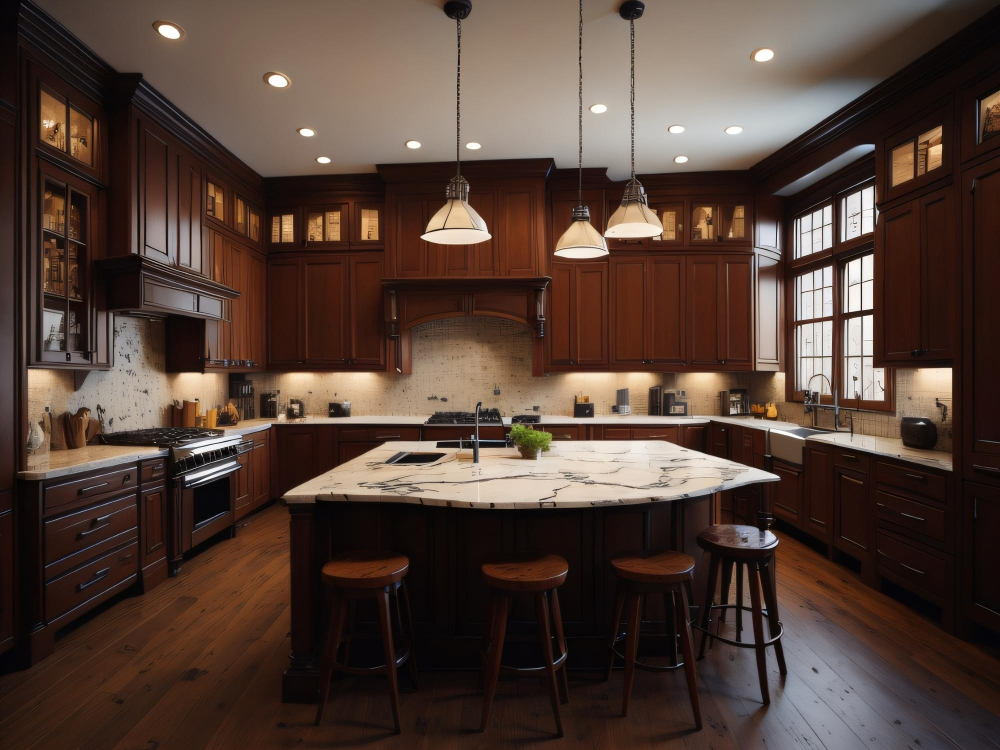
They come in various shapes, sizes, and colors that can complement any decor style. Hanging pendant lights over the kitchen island or dining table is an excellent way to create a focal point while providing task lighting.
When choosing pendant lights for your dark kitchen, consider the size of your space and the height of your ceiling. If you have high ceilings, opt for larger pendants with multiple bulbs that will provide ample light without overwhelming the room.
For lower ceilings or smaller spaces, choose smaller pendants with one bulb or cluster them together in groups of three or more for added impact.
Hang pendant lights at different heights to create depth and visual interest. For example, hang one light higher than others above an island counter while keeping them at equal heights above a dining table.
Choose Lighter Colors
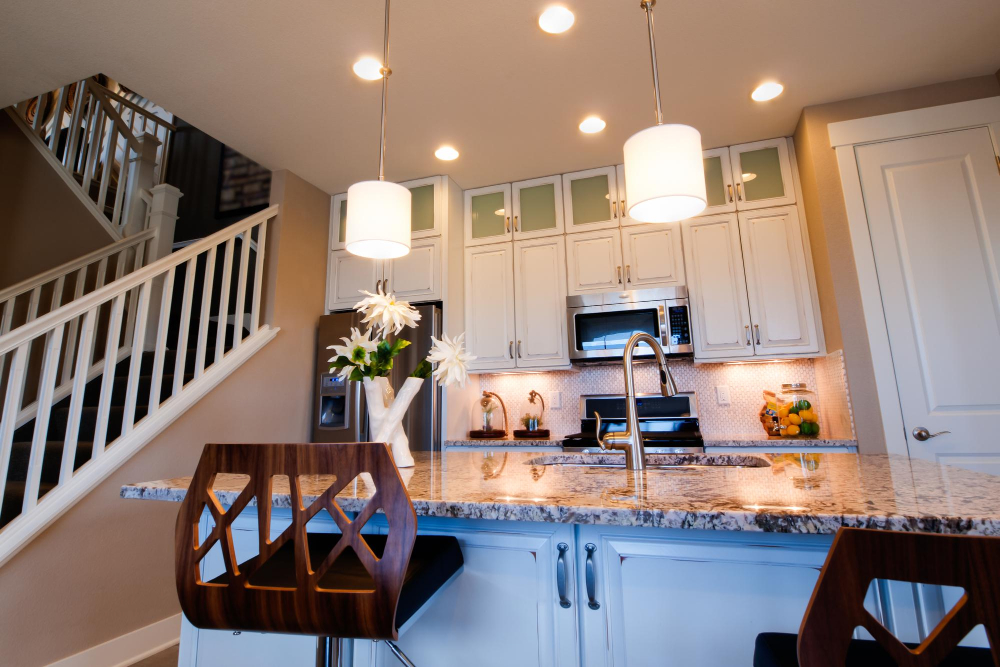
Lighter hues reflect more light and create an illusion of space. White is always a classic choice that works well in any kitchen style, but you can also experiment with other light shades such as cream, beige or pale gray.
If you’re not ready to commit to an all-white kitchen just yet, consider using white as an accent color instead. For example, painting your upper cabinets white while leaving the lower ones darker will draw the eye upward and make your ceiling feel higher.
Another way to incorporate lighter colors into your dark kitchen is through accessories like dishware or textiles. Choose items in bright hues like yellow or turquoise that will pop against darker surfaces.
Remember that when it comes to choosing lighter colors for a dark room less can be more – too many different shades can make the space feel cluttered rather than airy and open.
Paint Your Cabinets
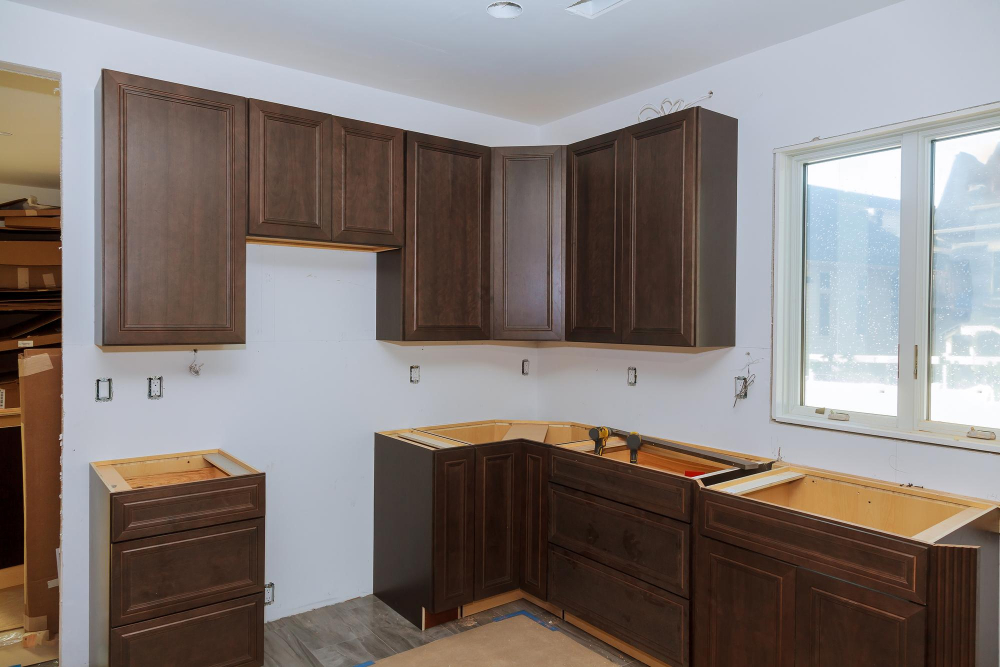
Dark wood or stained cabinets can make a room feel smaller and more enclosed. By painting them in lighter shades, you’ll instantly create the illusion of more space and light.
When choosing paint colors for your cabinets, opt for whites or light grays that will reflect natural light around the room. You could also choose pastel shades like pale blue or green to add some color without overwhelming the space.
Before starting this project, it’s important to prep your surfaces properly by cleaning them thoroughly with soap and water before sanding down any rough spots on the surface of each cabinet door. Once prepped correctly apply primer followed by two coats of paint using a brush or roller depending on preference.
Whitewash the Kitchen
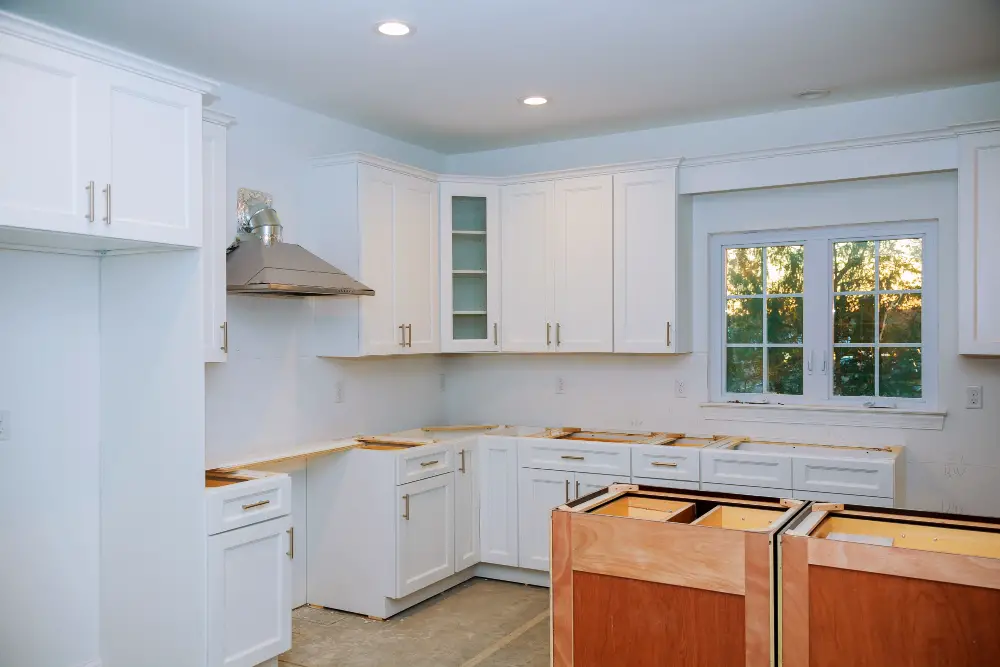
This technique involves applying a thin layer of white paint over the existing wall color, creating a soft and subtle effect that can make your space feel brighter and more open.
Whitewashing is an affordable option that doesn’t require any major renovations or construction work. It’s also versatile enough to complement different design styles, from rustic farmhouse kitchens to modern minimalist spaces.
To achieve this look, start by cleaning your walls thoroughly with soap and water. Once they are dry, mix equal parts of white latex paint with water in a bucket until it reaches the desired consistency (usually one part paint to one part water).
Then use a brush or roller to apply the mixture onto your walls in long strokes.
For best results, work in small sections at a time so you can blend each area seamlessly before moving on. You may need multiple coats depending on how dark your original wall color is.
Whitewashed walls pair well with light-colored cabinets or natural wood finishes for an airy feel.
Choose Lighter Cabinets
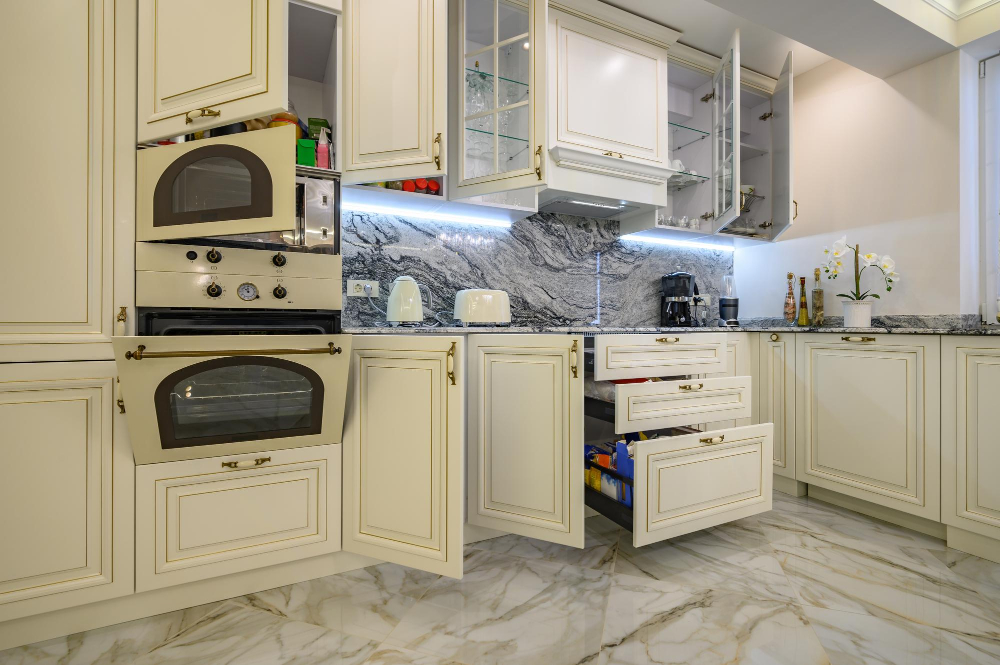
Lighter cabinets can make a significant difference in the overall brightness of the room and create an illusion of space. White or light-colored cabinetry reflects natural and artificial light better than darker shades, making them perfect for small kitchens or those without much natural lighting.
When choosing new cabinets, opt for materials that reflect light well such as glossy finishes or painted wood. You can also choose glass-fronted cabinet doors to add depth and allow more light into the interior spaces.
Replacing all your kitchen cabinetry may seem like an expensive undertaking but it’s worth considering if you want a complete transformation of your space. If budget is tight, consider painting existing dark wooden cupboards with white paint instead – this will give them a fresh look while still reflecting plenty of sunlight around the room.
Incorporate Light Wood
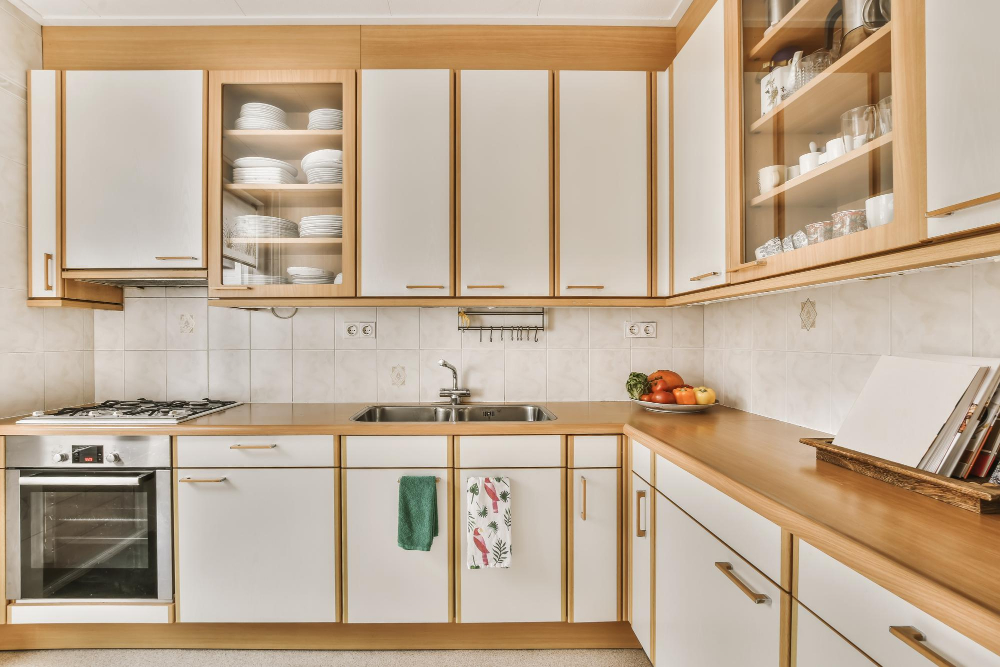
Light wood has a warm and inviting feel that can make any space feel more welcoming. You can use it in various ways, such as adding wooden shelves or cabinets with light-colored finishes.
Another option is to add wooden bar stools or chairs around the kitchen island. This will not only bring warmth and texture but also create an inviting atmosphere where family members and guests can gather around while cooking.
Moreover, if you have dark flooring in your kitchen, consider replacing it with lighter hardwood floors that complement the rest of the room’s decor. The contrast between dark cabinets and light floors creates an eye-catching look that makes everything pop.
Install Under-Cabinet Lights
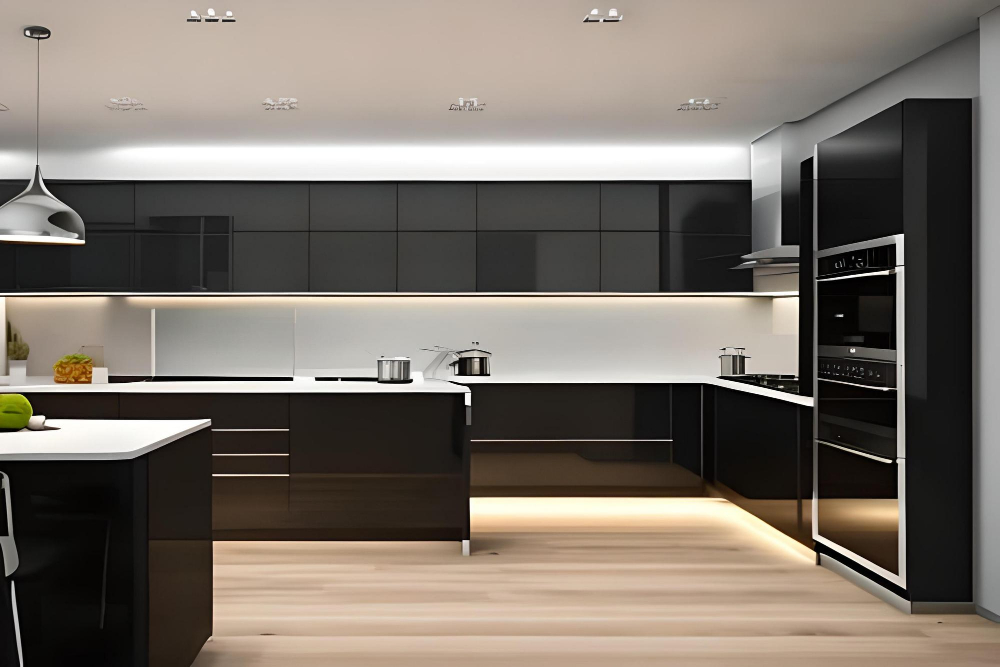
These lights are installed underneath the cabinets, providing direct light onto your countertops and workspaces. They come in different styles, including LED strips or puck lights that can be hardwired or plugged into an outlet.
Installing under-cabinet lights is relatively easy and can be done as a DIY project with the right tools. You’ll need to measure the length of your cabinets where you want to install them, then purchase enough light fixtures for each section.
Once you have everything ready, turn off power at the circuit breaker before starting any electrical work. Then drill holes for mounting brackets if necessary and attach them securely using screws provided with each fixture.
Next step is wiring: connect wires from one fixture to another until all fixtures are connected in series (or parallel). Finally plug-in transformer into an outlet nearby – it will convert 120V AC voltage down low-voltage DC required by LEDs inside under cabinet lamps.
Use LED Strip Lights
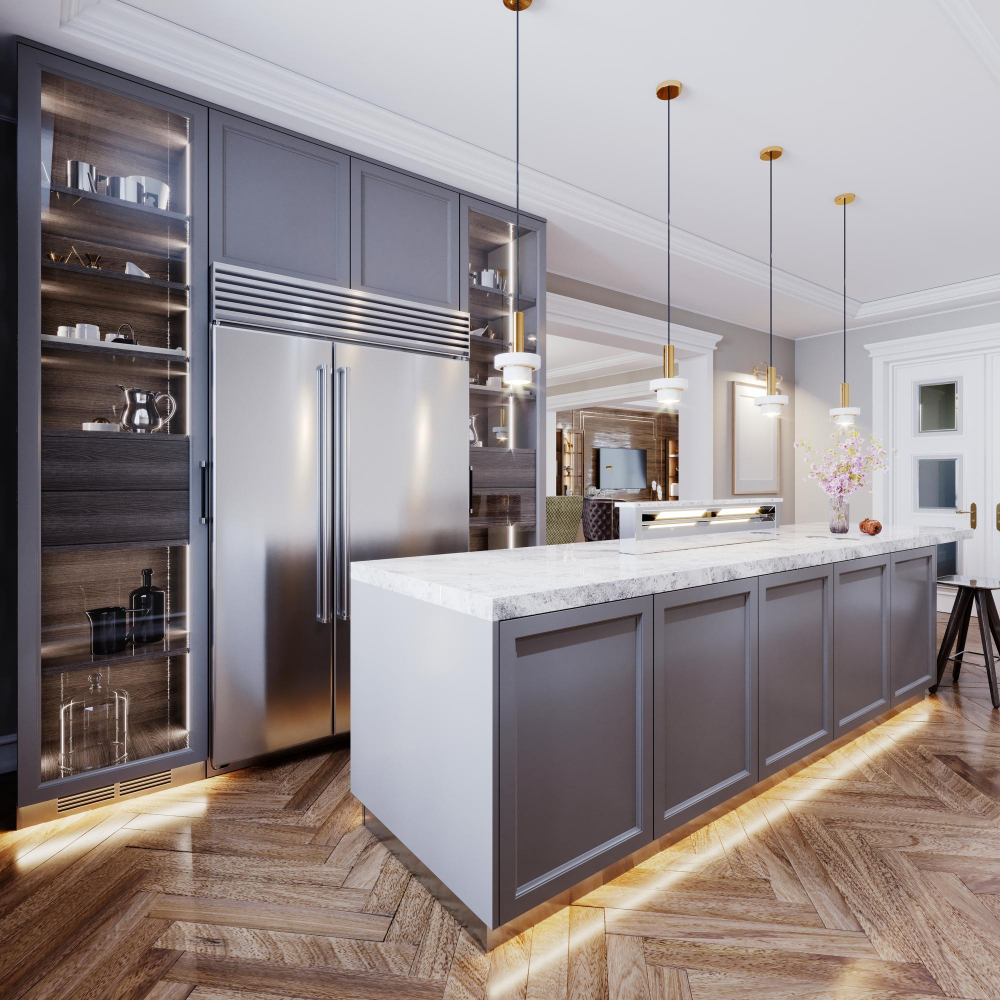
These versatile lights can be installed under cabinets, along the baseboards, or even on top of shelves for an added glow. They come in various colors and intensities, so you can choose the perfect one that suits your needs.
One of the best things about LED strip lights is that they’re energy-efficient and long-lasting. Unlike traditional incandescent bulbs, LED strips use less electricity and last much longer before needing replacement.
To install them in your kitchen, simply measure where you want them to go and cut the strips accordingly with scissors or a utility knife. Then peel off their adhesive backing tape and stick them onto any clean surface.
Upgrade to LED Light Bulbs

They use less energy than traditional incandescent bulbs and last much longer, which means you’ll save money on your electricity bill in the long run. Plus, they emit a brighter and more natural-looking light that can instantly make your dark kitchen feel brighter.
When upgrading to LED light bulbs, consider the color temperature of the bulb. A cool white or daylight bulb (5000K-6500K) will give off a bright white light that mimics natural sunlight and is perfect for task lighting in areas like above countertops or over sinks.
On the other hand, warm white (2700K-3000K) is ideal for creating an inviting ambiance in dining areas or around islands.
Another benefit of LED lights is their versatility – they come in various shapes and sizes to fit different fixtures such as recessed lighting cans or pendant lights.
Opt for Reflective Surfaces
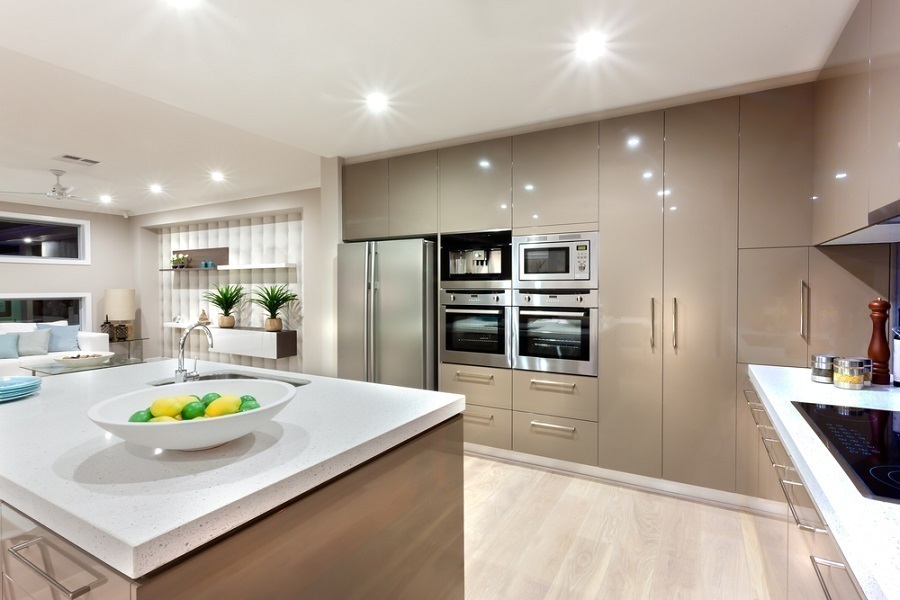
They reflect light and create an illusion of more space, making your kitchen feel brighter and bigger. You can incorporate reflective surfaces in many ways, such as using glossy tiles for the backsplash or installing mirrored cabinet doors.
Another option is to use stainless steel appliances or metallic finishes on hardware and fixtures. These materials reflect light beautifully while adding a modern touch to your kitchen design.
If you’re not ready for a full renovation, consider adding some reflective accessories like metallic vases or shiny utensils that will catch the light and add brightness to your space.
Remember that too much reflection can be overwhelming, so it’s important to balance it out with other textures like wood or matte finishes.
Mount a Mirror
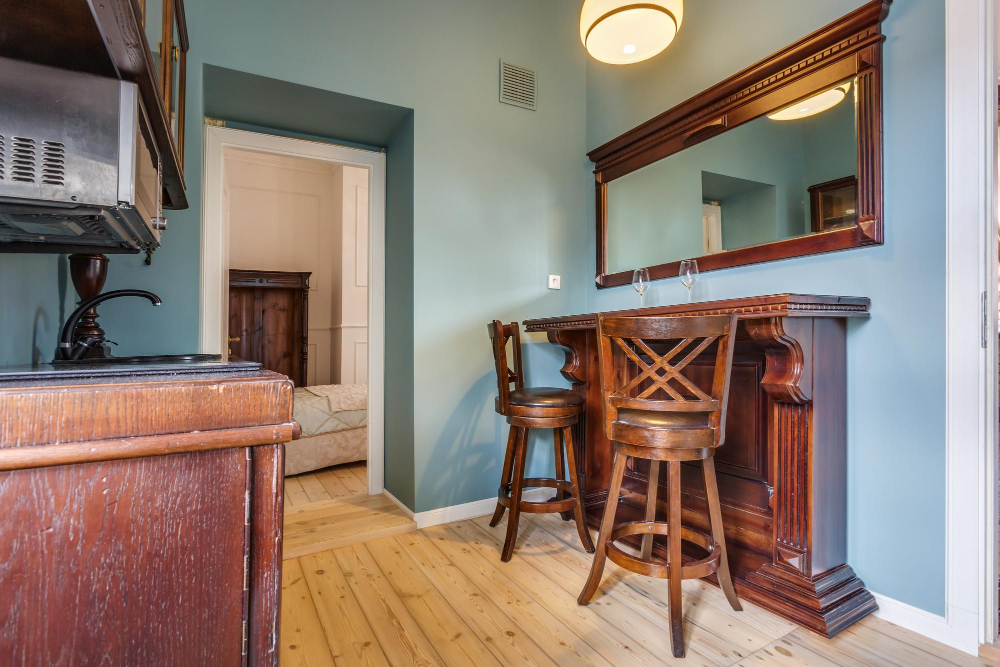
Mirrors reflect light and can make any space feel brighter and more spacious. You can hang a large mirror on one of the walls or even on the backsplash if you have enough space.
A mirrored backsplash not only adds brightness but also creates an illusion of depth, making your kitchen appear larger than it actually is.
If you don’t want to commit to a permanent installation, consider using removable adhesive hooks or suction cups to mount smaller mirrors in strategic locations around your kitchen. Place them opposite windows or light fixtures for maximum effect.
Decorate With Bright Accessories
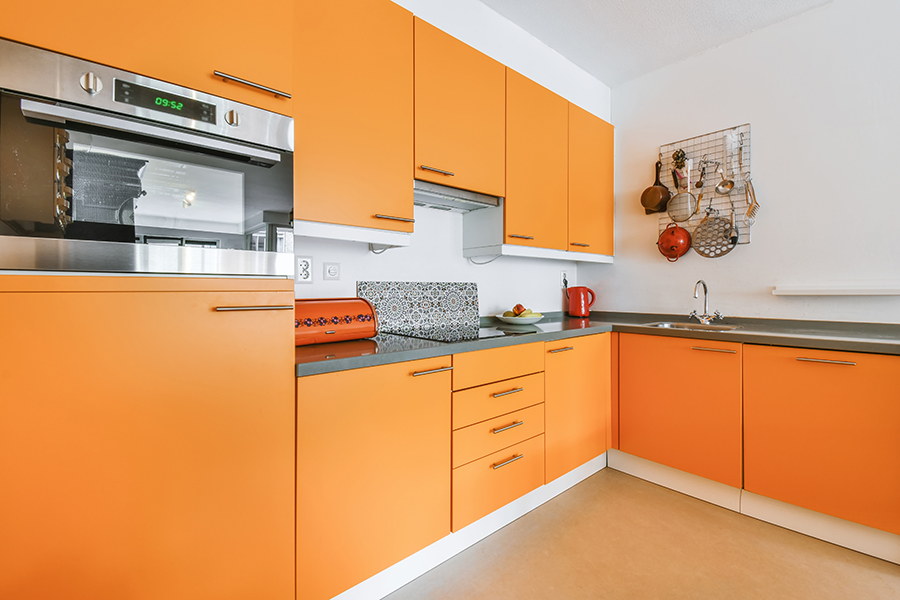
This can be done in many ways, such as using colorful dishware, vibrant placemats or table runners, and even brightly colored appliances like mixers or blenders. You can also add some greenery by placing potted plants on your windowsill or hanging them from the ceiling.
Another great way to incorporate color into your kitchen is through artwork and wall decor. Hang colorful paintings or prints that complement your existing color scheme for an instant pop of brightness.
When choosing accessories for your kitchen, keep in mind that less is often more when it comes to creating a cohesive look. Stick with one main accent color and use it sparingly throughout the space for maximum impact.
Use Metallic Accent Pieces
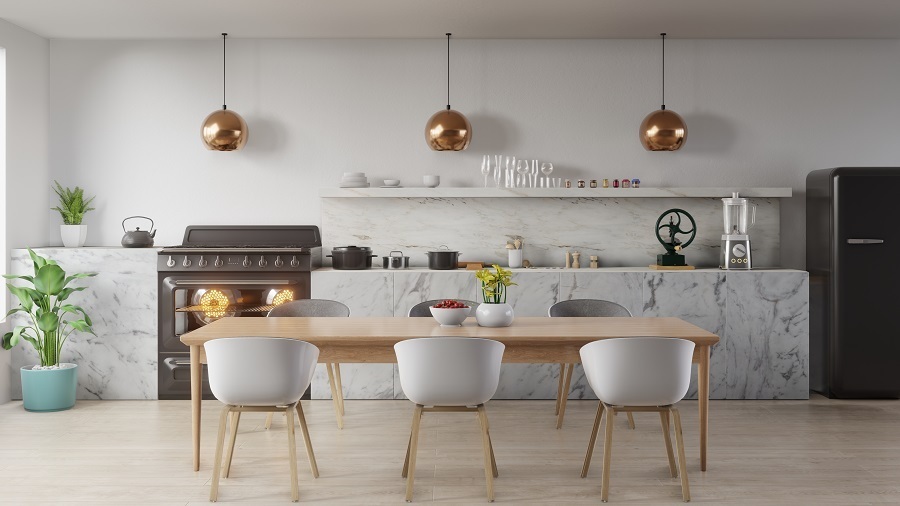
They reflect light, making the space feel brighter and more open. You can incorporate metallic accents in many ways, such as using stainless steel appliances or adding copper pots and pans on display.
Another idea is to hang a metallic pendant light over your kitchen island or dining table for an eye-catching focal point that draws the eye upward.
If you’re not ready for a big commitment, start small with metallic accessories like vases, candle holders or picture frames that will catch the light beautifully without overwhelming your space. Metallics work well with any color scheme but look especially stunning when paired with white cabinets or countertops.
Remember not to go overboard; too much metal can make your kitchen feel cold and sterile instead of warm and inviting.
Open Shelving Ideas
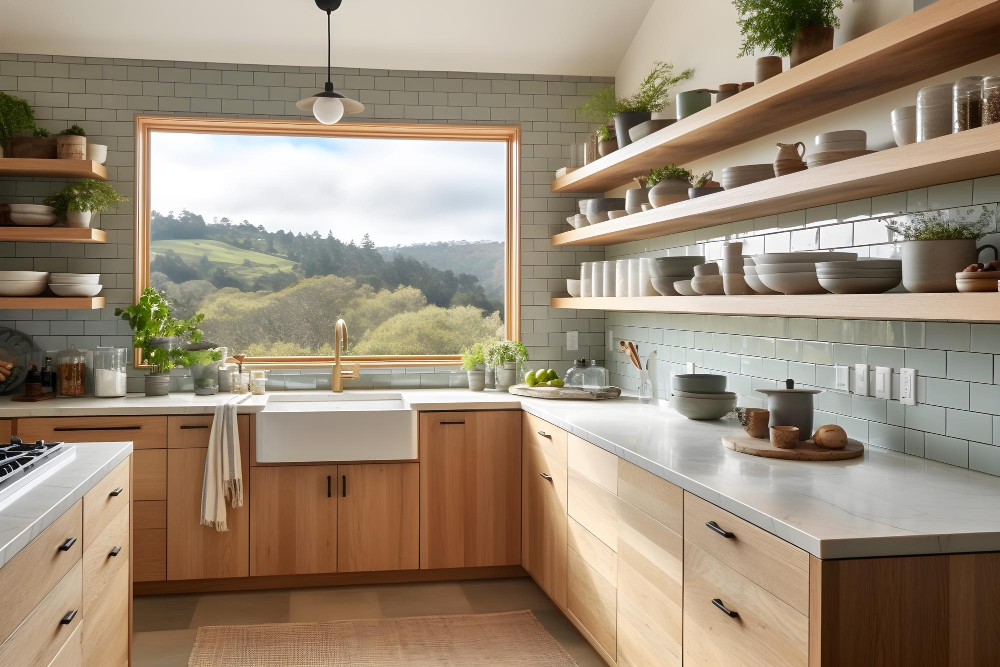
Open shelves not only add storage space but also create an illusion of more light and space in your kitchen. You can use them to display your favorite dishes, glasses, or even plants.
To make the most out of open shelving, consider painting the back wall with a lighter color or adding wallpaper for contrast. This will help highlight your items on display and draw attention away from any darker areas in your kitchen.
Another idea is to mix and match different types of shelves such as wood, metal or glass for added interest. You can also play around with different shapes like hexagons or triangles instead of traditional rectangular shapes.
If you’re worried about dust collecting on exposed items, try using clear acrylic shelf liners that are easy to clean while still allowing you to see through them.
Opt for Open Shelving
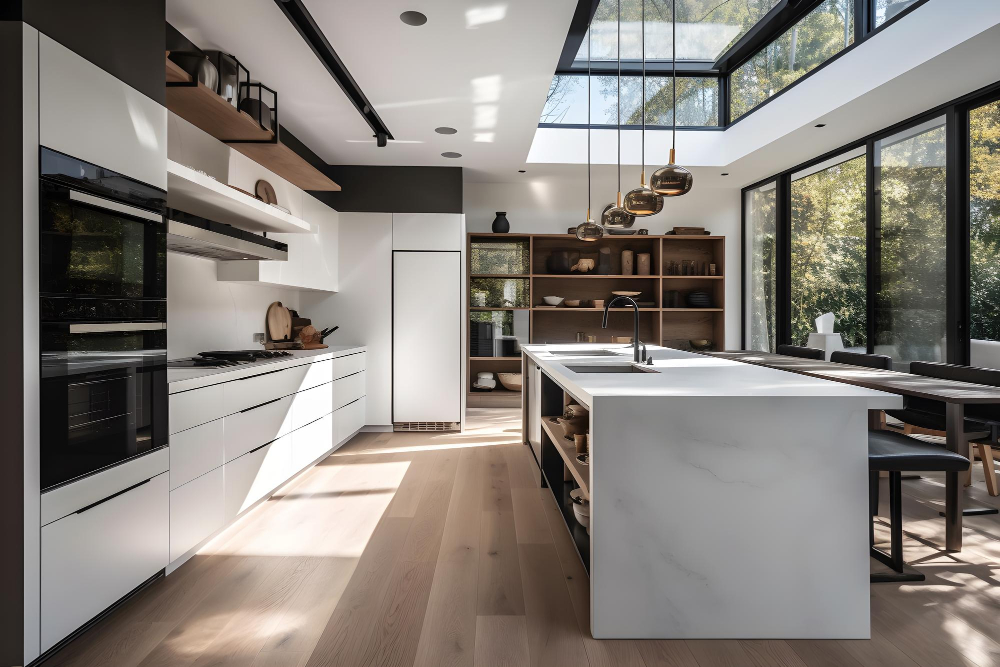
Closed cabinets can make a small, dark kitchen feel even more cramped, while open shelves allow light to flow freely throughout the space. Plus, they give you the opportunity to display your favorite dishes and accessories.
When choosing open shelving for your kitchen, consider using floating shelves or brackets that are painted in a light color that matches or complements your walls. This will help them blend seamlessly into the background and keep visual clutter at bay.
Another option is glass-fronted cabinets which offer similar benefits as open shelving but with added protection from dust and grease buildup on dishes.
If you’re worried about keeping everything organized on open shelves, try grouping items by color or type of dishware for an aesthetically pleasing look. You can also use baskets or bins to corral smaller items like spices or utensils.
Glass Cabinet Doors
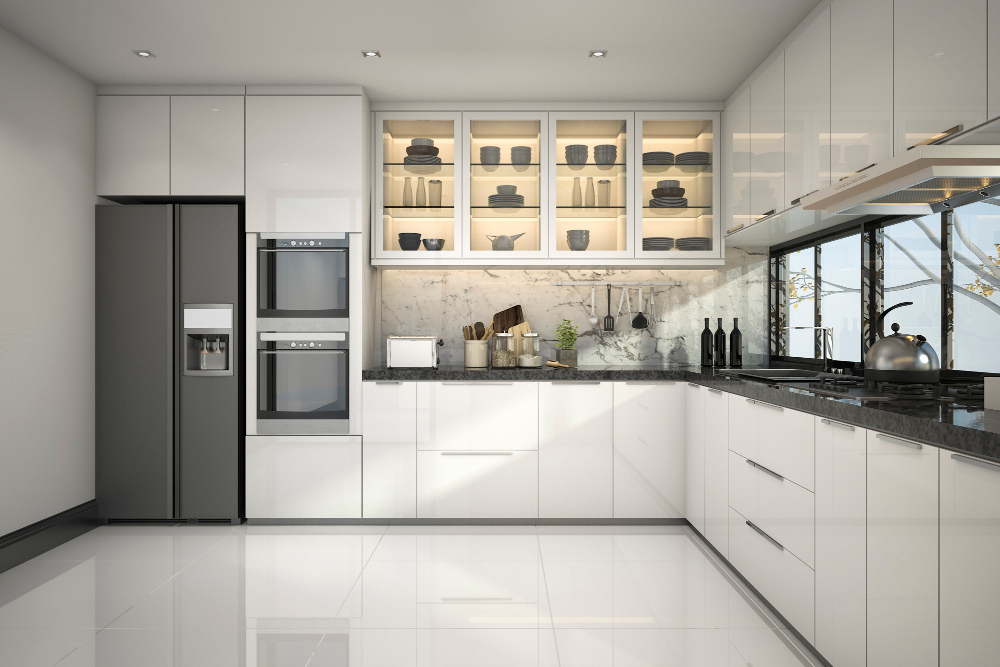
They allow light to pass through, making the space appear larger and brighter. Glass cabinet doors also provide an opportunity to showcase your favorite dishes or decorative items.
If you have dark cabinets in your kitchen, consider replacing some of them with glass cabinet doors. This will instantly add a touch of elegance and sophistication while allowing natural light into the room.
Another option is to remove the solid panels from existing cabinets and replace them with glass inserts. This is a cost-effective solution that can be done by most homeowners without professional help.
When choosing glass for your cabinet doors, consider frosted or textured options if you want some privacy while still letting in light. Clear glass works well if you want maximum visibility for displaying items inside.
Transparent Chairs
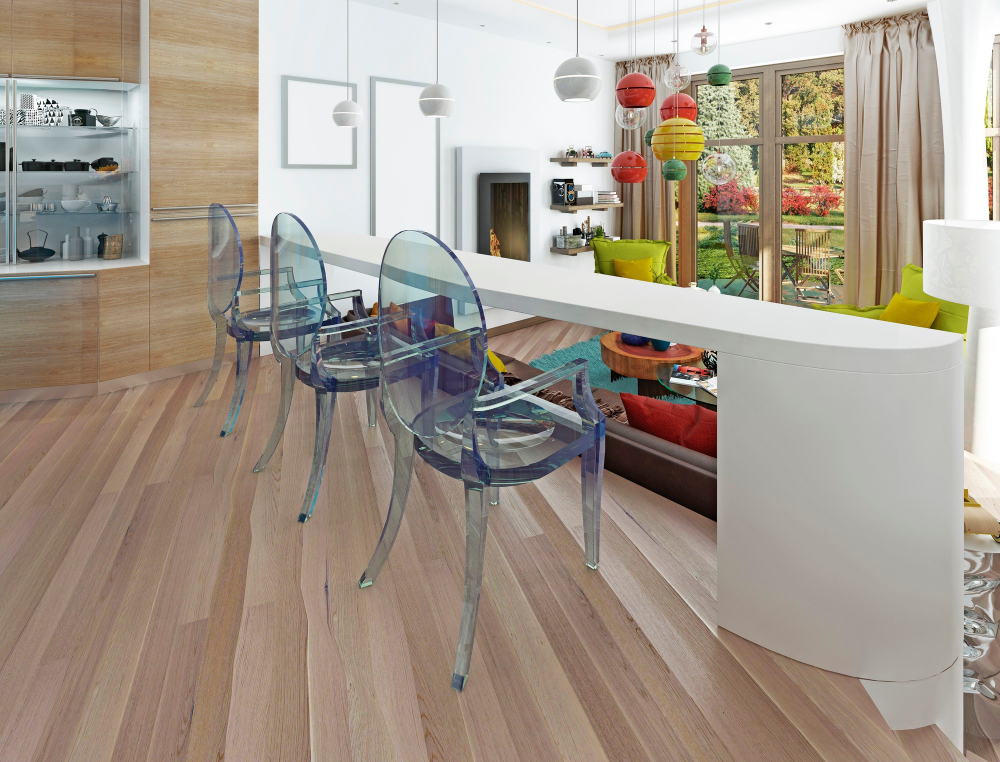
These chairs come in various styles and designs, from classic ghost chairs to modern acrylic options. They blend seamlessly into any decor style and allow light to pass through them, making the room feel more open and airy.
If you have a small kitchen or limited floor space, transparent chairs can be an excellent solution for creating additional seating without overcrowding the area. Plus, they’re easy to clean and maintain since they don’t stain or absorb spills like upholstered seats.
When choosing transparent chairs for your kitchen, consider their height as well as their design. You want them to fit comfortably under your table or counter while still providing enough legroom for guests.
Light-Colored Kitchen Island
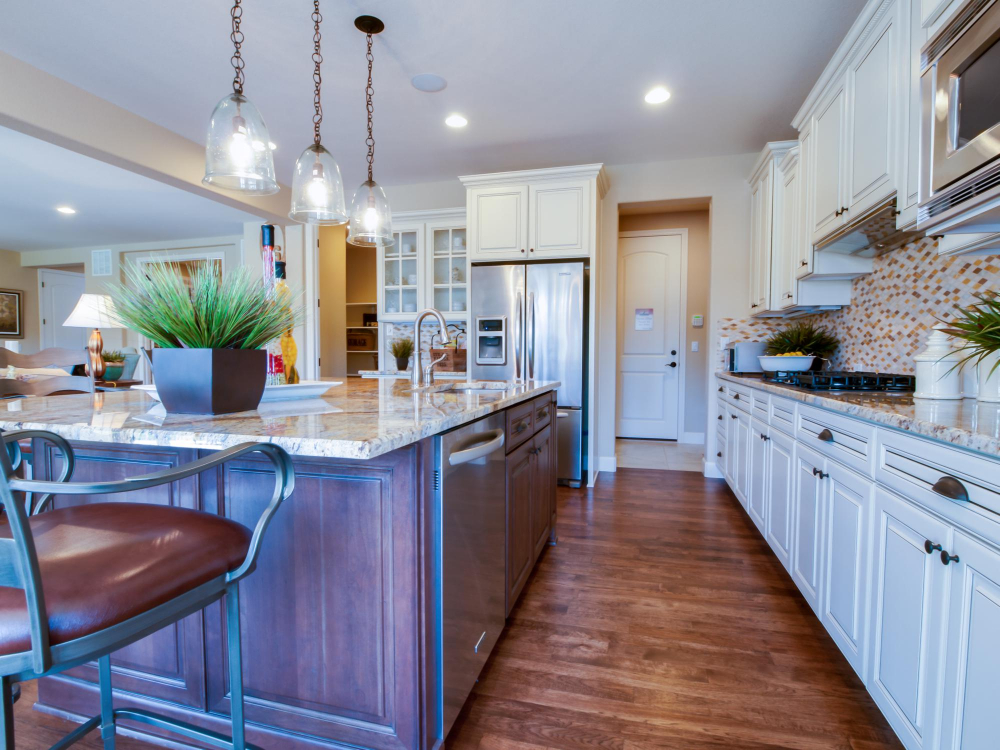
It not only adds extra counter space but also serves as an anchor for the room. A white or light-colored island will reflect natural and artificial light, making your entire kitchen feel brighter and more spacious.
If you have existing cabinetry that is dark, consider painting your island in a lighter shade to create contrast. You could even add some open shelving or glass cabinet doors to showcase bright dishes or accessories.
When choosing materials for your new island, opt for reflective surfaces like marble or quartz with subtle veining patterns that will catch the eye without overwhelming the space. If you prefer wood finishes, choose lighter woods like maple or birch instead of darker options like cherrywood.
Light-Colored Flooring
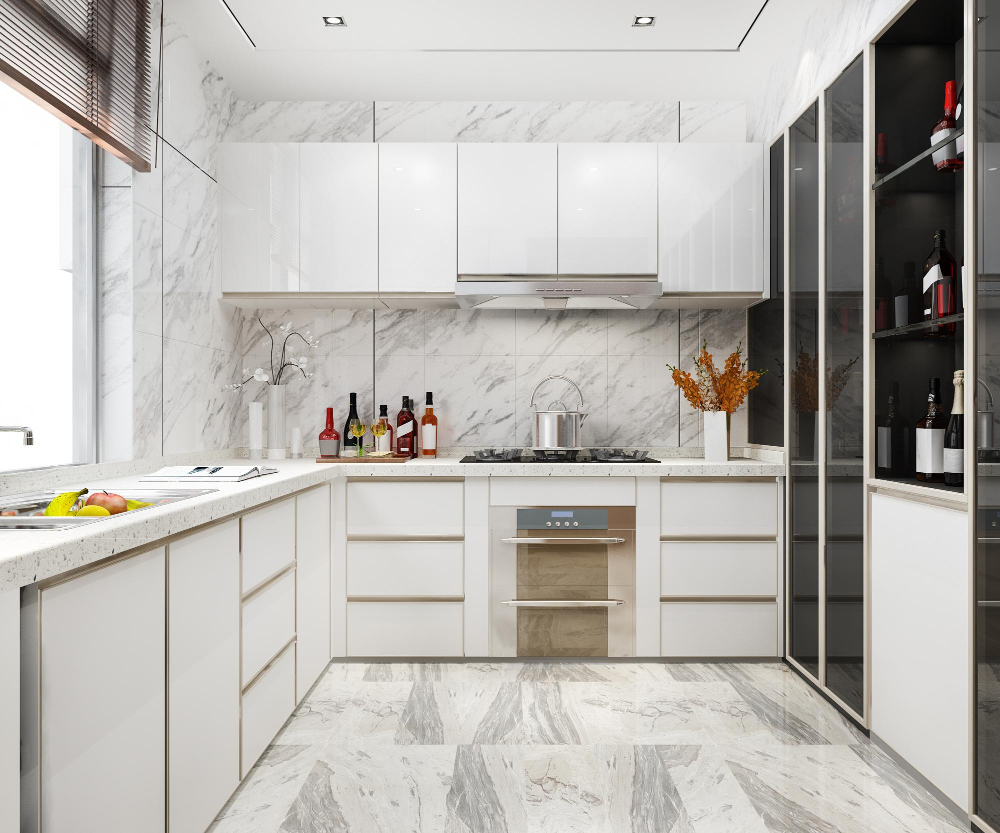
Dark floors can make a room feel smaller and more enclosed, while lighter floors reflect more light and create the illusion of space. Light wood or tile flooring in shades of white, beige, or gray are great options for brightening up your kitchen.
If you’re not ready to replace your existing floor, consider adding a large area rug in a lighter color to help lighten up the space.
Backsplash Options
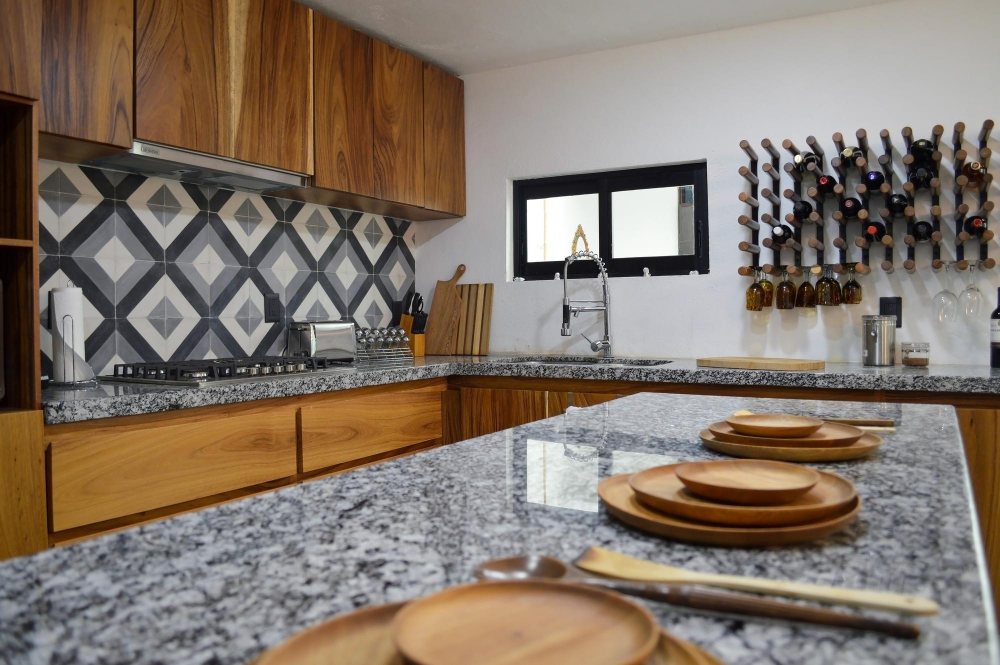
But if you have a dark kitchen, choosing the right backsplash can be tricky. Here are some options that will help brighten up your space:
– Add Glass or Metallic Backsplash: A glass or metallic backsplash reflects light and adds shine to your kitchen. It’s also easy to clean and maintain.
– Cover Dark Backsplash with Peel-and-Stick Tile: If you don’t want to replace your existing tile, consider covering it with peel-and-stick tiles in lighter colors. This is an affordable option that can make a big difference.
When choosing a new backsplash for your dark kitchen, keep in mind that lighter colors reflect more light than darker ones.
Add Glass or Metallic Backsplash
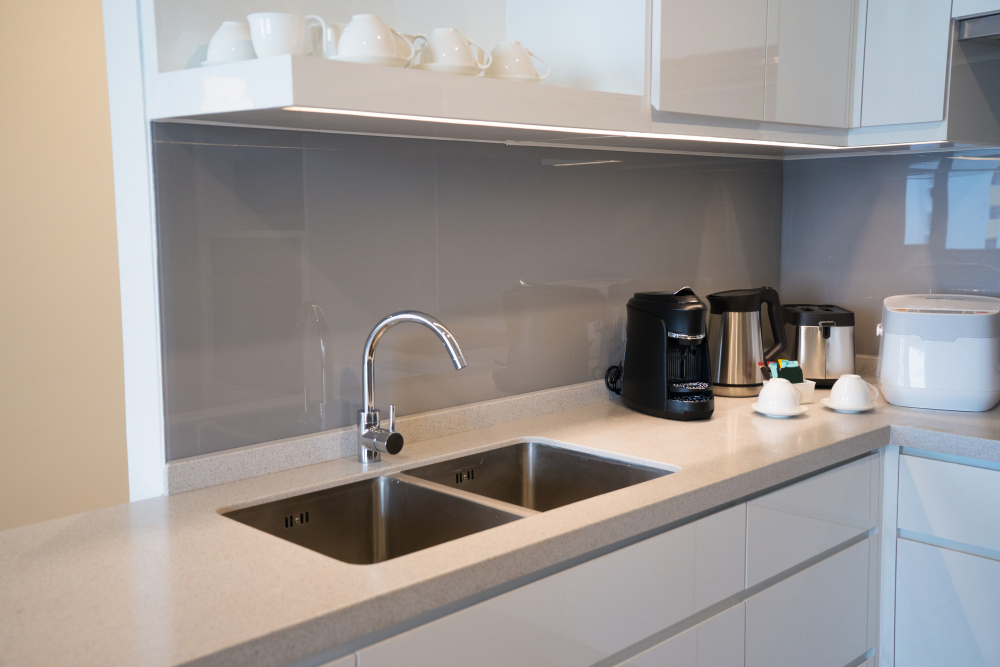
Glass and metal reflect light, making the space feel brighter and more open. Plus, they’re easy to clean and maintain.
A glass backsplash can be installed in large sheets or smaller tiles, depending on your preference. It’s available in a variety of colors and finishes that can complement any kitchen style.
A mirrored finish will reflect even more light into the room.
Metallic tile options include stainless steel, copper, brass or aluminum which are all reflective materials that add shine to your space while also being durable enough for everyday use.
Both options are modern alternatives to traditional tile backsplashes but still provide functionality with their ability to protect walls from splatters while adding an element of sophistication at the same time.
Cover Dark Backsplash With Peel and Stick Tile
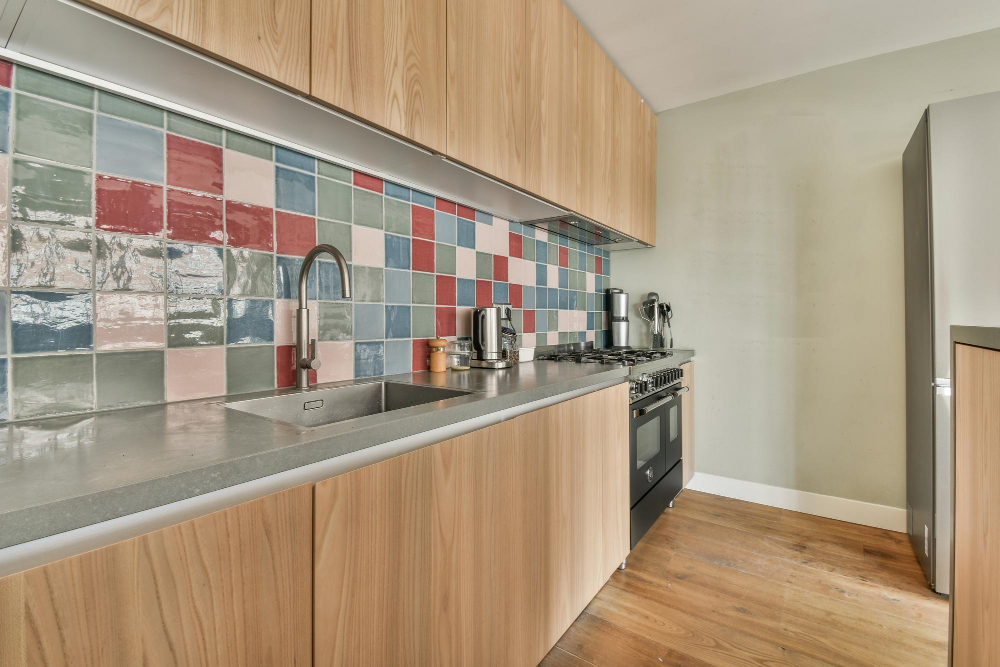
This is an easy and affordable way to brighten up your space without having to replace the entire backsplash. Peel and stick tiles come in a variety of colors, patterns, and textures so you can choose one that complements the rest of your kitchen decor.
To get started, clean the surface of your existing backsplash thoroughly before applying the peel-and-stick tiles. Measure out how much tile you’ll need by measuring both lengthwise as well as height-wise for accuracy.
Once you’ve got everything measured out correctly, start at one end or corner of the wall where there are no cabinets or appliances in order to avoid any obstacles while installing them. Carefully apply each piece according to manufacturer instructions until all areas are covered evenly.
Glass Countertops
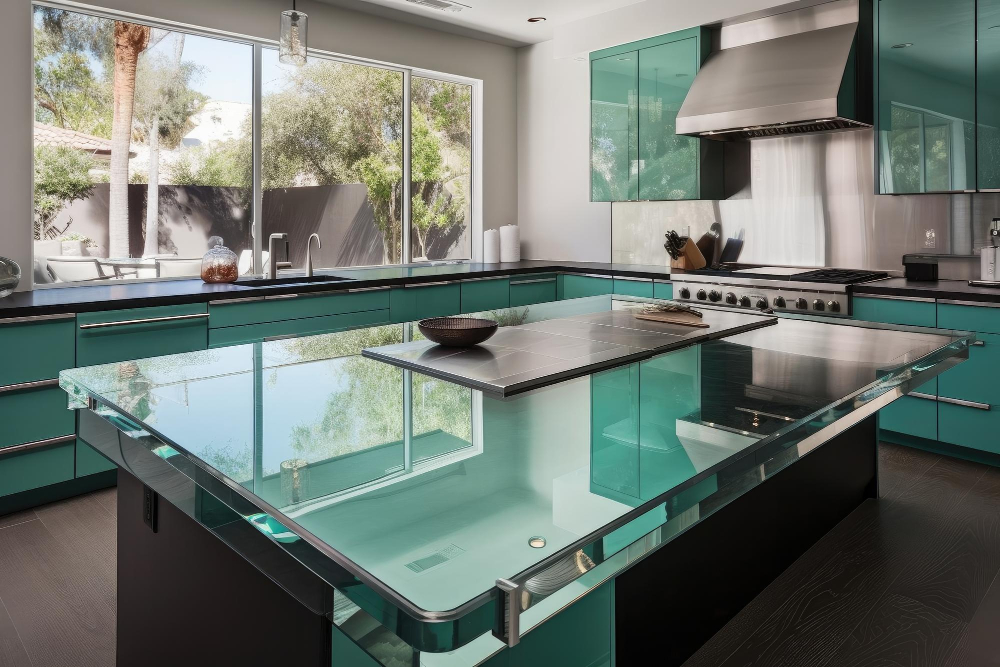
They reflect light, making the space feel brighter and more open. Plus, they’re easy to clean and maintain.
There are two types of glass countertops: back-painted glass and textured glass. Back-painted glass is made by painting the underside of clear tempered or laminated glass with a color that matches your kitchen’s decor.
Textured glass has patterns or designs etched into it for added visual interest.
One thing to keep in mind when considering a glass countertop is that it can scratch easily if you’re not careful with sharp objects like knives or metal utensils. However, scratches can be buffed out using special polishing compounds.
Lightening a Dark Countertop
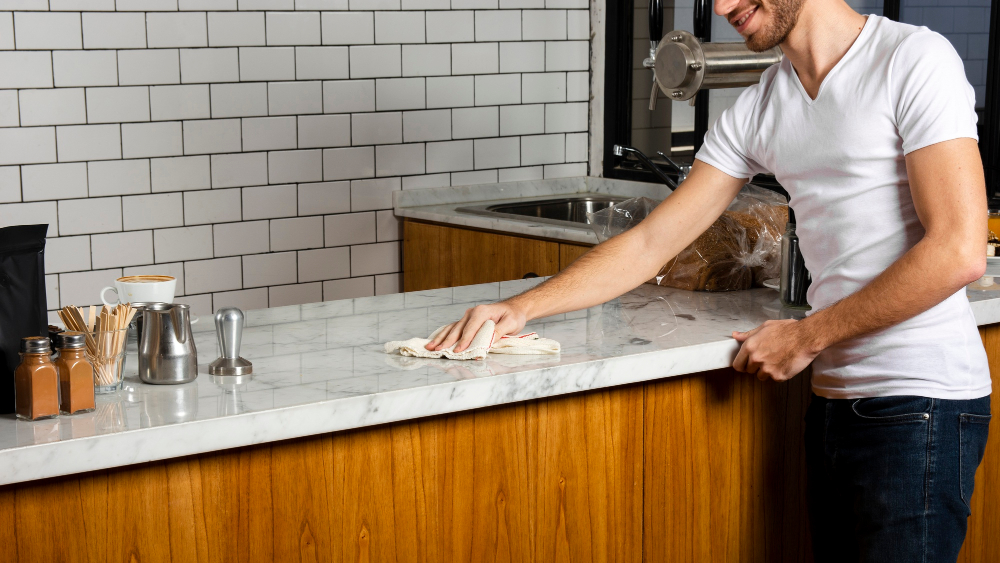
One of the easiest and most affordable solutions is to use a light-colored cutting board or placemat on top of the counter. This will not only add brightness but also protect your countertop from scratches.
Another option is to paint your countertops with a lighter color using special paint designed for this purpose. You can choose from various colors that mimic natural stone or opt for solid white if you want an ultra-modern look.
If painting isn’t an option, consider covering the countertop with contact paper in a light color or pattern that complements your kitchen decor. Contact paper comes in many different designs and textures, so you’re sure to find one that suits your style.
If none of these options work for you, consider replacing the entire countertop with something lighter such as quartz or marble.
Change Dark Kitchen Cabinet Hardware
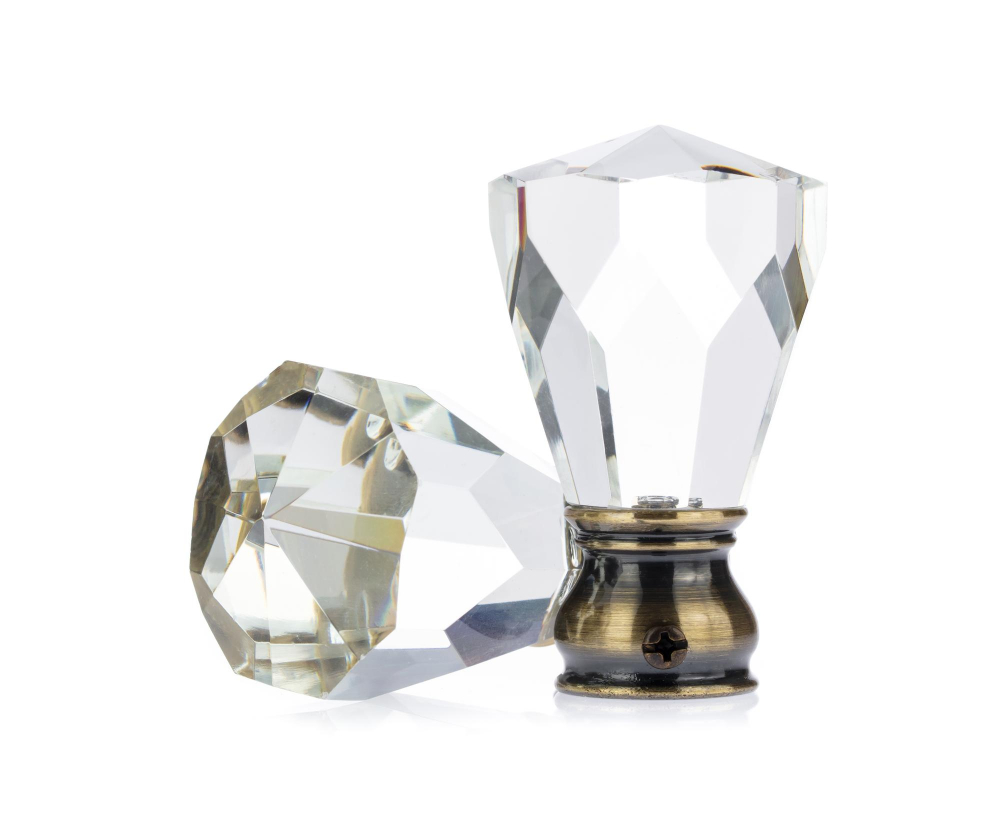
Dark knobs and pulls can make your cabinets look heavy and dated, but swapping them out for lighter options can give them an instant facelift.
Choose hardware in finishes like brushed nickel or chrome that reflect light instead of absorbing it. You could also opt for glass or crystal knobs that sparkle when they catch the light.
Don’t be afraid to mix and match different styles of hardware either – this is a great opportunity to add some personality to your kitchen while still keeping things cohesive. Just make sure all the pieces have a similar finish so they don’t clash with each other.
Add a Breakfast Nook
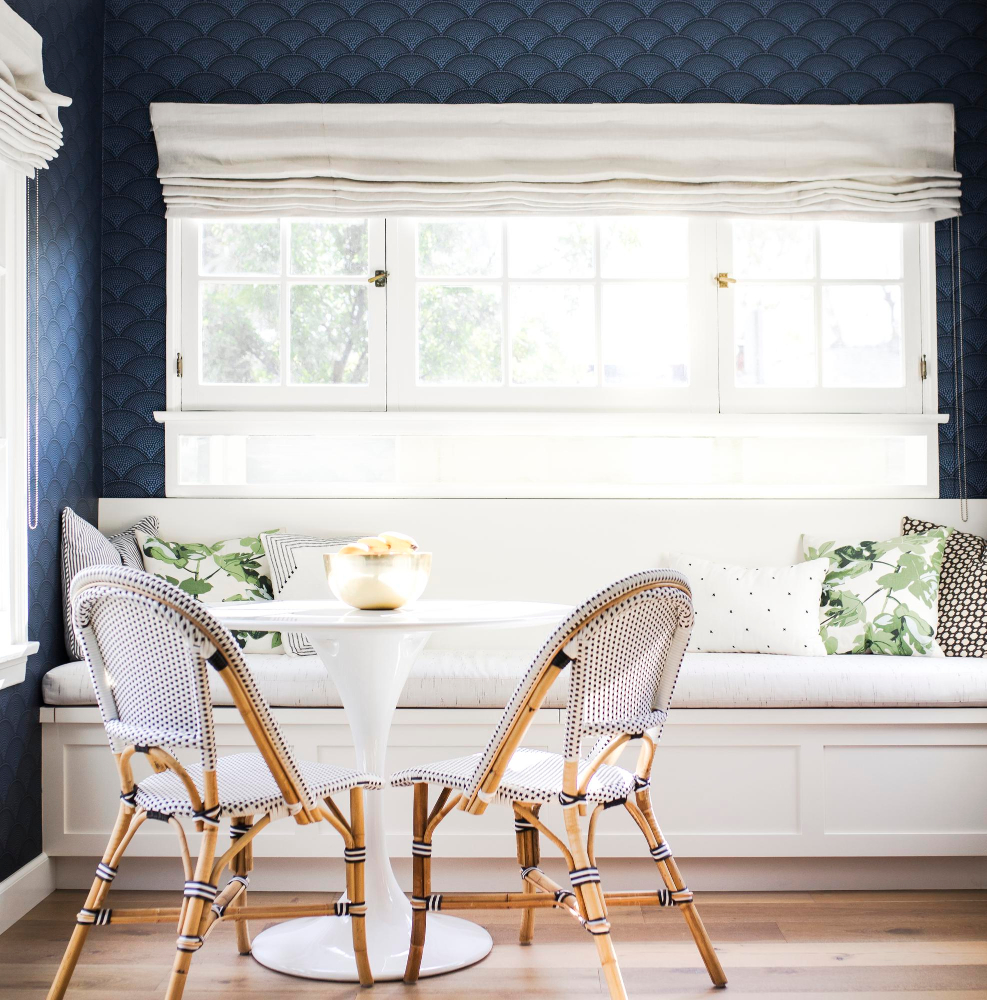
A breakfast nook is typically located in or near the kitchen and provides a cozy spot for enjoying meals with family or friends. You can add some colorful cushions, tablecloths, or curtains to make it feel even more inviting.
To create your own breakfast nook, all you need is a corner of your kitchen that’s not being used effectively. Consider installing built-in benches along two walls with comfortable cushions on top and then add a small table in between them.
If space allows, hang pendant lights above the table for added brightness.
A breakfast nook doesn’t have to be expensive either; there are plenty of DIY options available online that will help you save money while still achieving great results! With just some basic carpentry skills and creativity, anyone can build their own custom-made bench seating area perfect for morning coffee breaks or casual dinners at home.
Add Bright Pops of Color
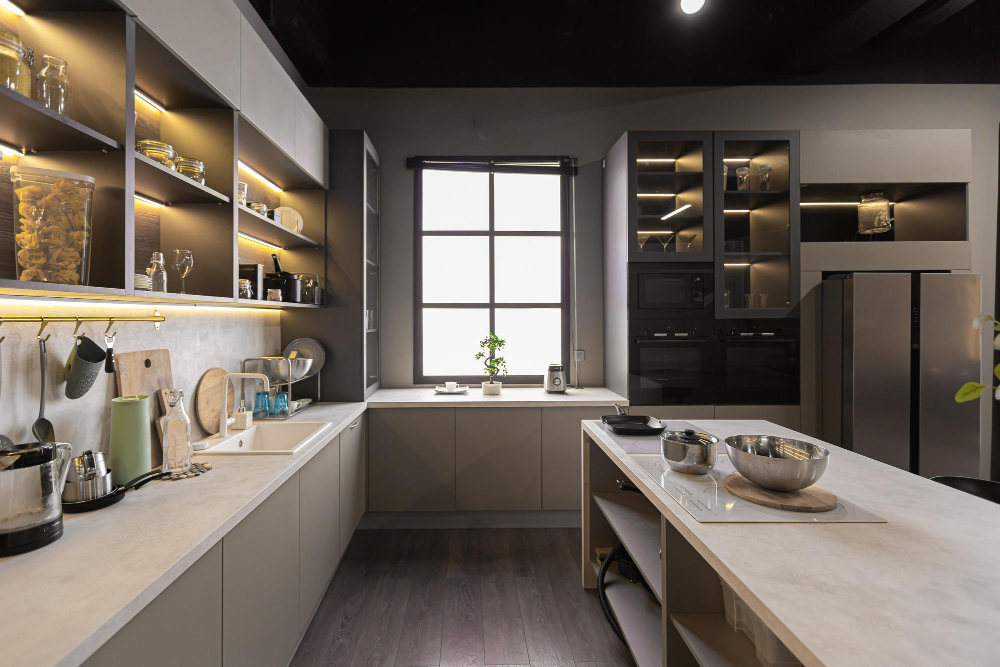
You can do this by incorporating colorful accessories such as dish towels, placemats, or even a brightly colored fruit bowl. Consider adding some fresh flowers in a vase on your countertop or table for an instant burst of color.
Another great way to add pops of color is through artwork. Hang colorful paintings or prints on the walls to create visual interest and draw the eye away from darker areas.
If you’re feeling bold, consider painting one wall in your kitchen with a bright accent color that complements your existing decor. This will not only add brightness but also create depth and dimension in the space.
Remember that when it comes to adding pops of color, less is often more. Stick with one or two colors at most so as not to overwhelm the space visually.
By following these simple tips for adding bright pops of colors into your dark kitchen design scheme, you’ll be able to transform it into an inviting and cheerful space where you’ll love spending time cooking meals for yourself and loved ones alike!.
FAQ
What is the best lighting for a dark kitchen?
The best lighting for a dark kitchen is under-the-cabinet lighting, such as puck lights, fluorescent light bars, or LED light bars.
How can I lighten my dark cabinets without painting?
To lighten your dark cabinets without painting, you can apply household bleach with a scrub brush and let it dry in the sun, which will significantly lighten the wood.
What are some cost-effective ways to increase natural light in a dark kitchen?
Some cost-effective ways to increase natural light in a dark kitchen include installing mirrors, painting walls with lighter colors, and using sheer window treatments.
Which colors and materials are most effective for brightening up a dark kitchen space?
Effective colors and materials for brightening up a dark kitchen space include light hues, reflective surfaces, and natural light.
Can strategically placed mirrors help brighten a dark kitchen? If so, how?
Yes, strategically placed mirrors can help brighten a dark kitchen by reflecting light from windows or artificial sources to illuminate darker areas more effectively.



